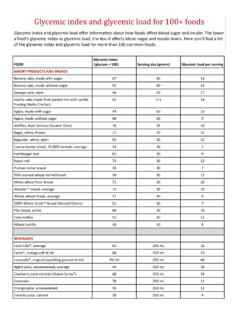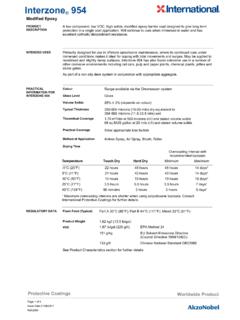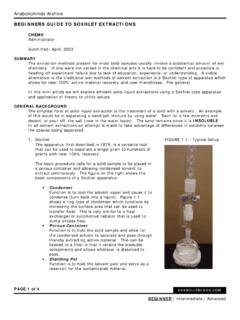Transcription of YOGURT MADE SIMPLE - OSU Extension Service
1 YOGURT MADE SIMPLE . By Diane K. Smith, Assistant Professor, WSU Extension Youth and Families Program FS173E. FS173E | Page 1 | WSU Extension | YOGURT MADE SIMPLE . YOGURT Made SIMPLE The smooth, creamy slightly tart taste of homemade YOGURT is produced by bacterial fermentation of milk. YOGURT is the most popular fermented milk in the world and can be made with any type of milk by following SIMPLE steps of (1) heating the milk, (2) adding YOGURT starter, also known as a mother culture, . which is the source of bacteria, and (3) then allowing the milk to incubate for 6-8 hours.
2 YOGURT originated many centuries ago among the nomadic tribes of Eastern Europe and Western Asia, where herdsman began the practice of milking their animals and storing the milk in containers made from animal stomachs. The natural enzymes in the containers curdled the milk, essentially making YOGURT . Not only did the milk keep longer, it is thought that people preferred the taste, so the practice continued. Over the centuries the process of making YOGURT has evolved into YOGURT as we know it today. YOGURT is a rich source of protein and calcium, and the fermentation process makes these nutrients easier to absorb by our bodies (Figure 1).
3 Ongoing studies continue to reveal the many health benefits of eating YOGURT , such as boosting immunity, reducing yeast infections, and lowering the risk of colon cancer (Dairy Council of California 2015). Safety, Spoilage, and Shelf Life YOGURT production has two characteristics that provide barriers to pathogen growth: heat and acidity (low pH). Both of these Figure 1. The nutrition facts for whole milk YOGURT . factors are necessary to ensure a safe product. Recent outbreaks of food poisoning by E. coli O157:H7 that is acid- The acidity of YOGURT tends to be in the range of pH tolerant, brings into question the protective mechanism of more lactic acid produced, the tangier the YOGURT will taste.
4 Acidity alone. However, E. coli O157:H7 is easily destroyed by The final taste and consistency of the YOGURT can be influenced pasteurization (heating), therefore, when making YOGURT it is by the type of YOGURT starter used and length of incubation time. necessary to pasteurize the milk or use commercially pasteurized milk (Nummer 2002). The thickness of the YOGURT results from the coagulated proteins determined by the fat content of the milk, the YOGURT YOGURT generally has a 10- to 21-day shelf life when made starter, and amount of milk solids (protein).
5 Adding nonfat properly, and stored in the refrigerator at temperatures below milk powder (milk solids) to cold milk before heating will 40 F. Molds, yeasts, and slow growing bacteria can spoil the result in a firmer YOGURT . However, adding nonfat milk powder YOGURT when it is stored over a longer time. To ensure long to heated milk will cause some proteins to coagulate and form shelf life, always use clean and sanitized equipment and strings. containers. A best practice is to clean the container with detergent using hot water, then rinse well and air dry.
6 The YOGURT starter is the source of bacteria. The tartness of the YOGURT will depend on the bacteria culture that is used, as well as how long the YOGURT has fermented. A YOGURT starter can be The Chemistry of YOGURT a store-bought YOGURT that has active live bacteria, or a previously made batch of YOGURT that is about 5 to 7 days old YOGURT forms when bacteria ferment the milk sugar, known as (for the freshest and most active bacteria). Freeze-dried starter lactose, into lactic acid. The lactic acid makes the milk more or an heirloom culture bacteria in powder form can often be acidic (lower pH) causing the proteins to coagulate.
7 Purchased at local natural-food stores or from online vendors. FS173E | Page 2 | WSU Extension | YOGURT MADE SIMPLE . Figure 2. Steps to making YOGURT on the stovetop. A) Inoculate milk by heating to 180oF. B) Allow milk to cool to 108oF to 112oF, then add YOGURT starter. C). Pour cultured milk into clean containers, cover and place in incubator. Only a small amount of fresh YOGURT culture is needed to start the fermentation process about 2 to 3 teaspoons per cup of 5. Incubate the YOGURT by setting it in a warm place for 6. milk. If too much starter culture is used, the bacteria will be to 8 hours undisturbed.
8 The goal is to maintain constant crowded and run out of food (lactose) before the YOGURT is set. temperature to allow the YOGURT to ferment. The time Too much starter can produce a sour taste, rather than the will vary depending upon the size of the inoculation desired tart taste. culture, temperature, lactose content of the milk, and/or the freshness (vitality) of the YOGURT starter used. Any YOGURT Made SIMPLE : Step by one or a combination of these factors will increase the time to complete the process. Step on the Stove Top 6. Refrigerate YOGURT immediately once the YOGURT has congealed to a jell-like consistency.
9 Rapid chilling Steps for making stove-top YOGURT are illustrated in Figure 2. stops the development of acid. 1. Pour milk of choice into a double boiler and heat to Recipe for Plain YOGURT (Cascio and Rodgers Dinste 2011). 180 F. This will kill competing bacteria, and the whey proteins will denature and coagulate to enhance the viscosity and texture of the final product. Maintain temperature for 10 minutes for thinner YOGURT , 20. minutes for thicker YOGURT . 2. After the milk has reached 180 F for the desired time, remove from heat and allow to cool to 108 F to 112 F.
10 3. When the milk is cooled, scoop out one cup of milk into Incubation. There are a number of ways to incubate YOGURT , including in an oven, in an insulated cooler, in a crockpot, and a small mixing bowl. To this cup of milk, add the 2 to 3. in a commercial YOGURT machine (Figure 3). teaspoons of YOGURT starter per cup of milk. For example, for a quart of milk add 8 to 12 teaspoons (2. 1. In the oven. Pre-warm oven to 200 F, then turn off. 1/2 to 4 tablespoons) YOGURT starter. Turn oven on for short periods so that the temperature 4. Pour this mixture back into the larger portion of heated does not drop below 100 F.













